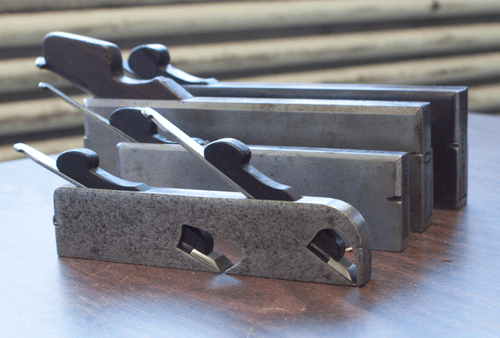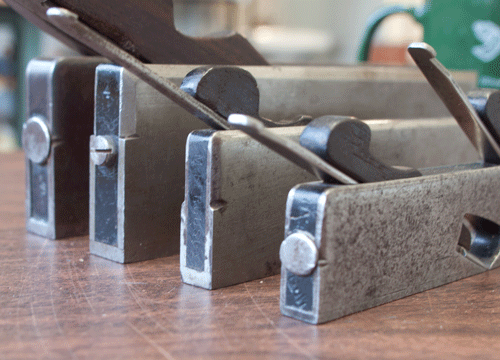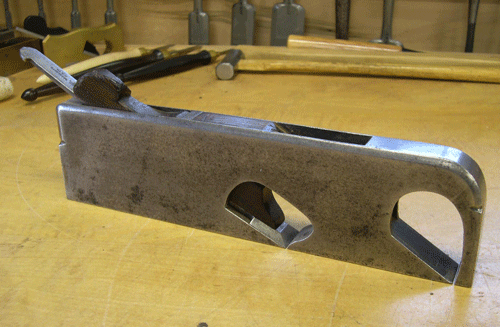 Before the 1860's iron rebate planes were pretty common. Robert Towell, the earliest specialist iron plane maker made a bunch, as did other makers. Then the shoulder plane was invented, and rebate planes become scarce. Shoulder planes were purpose designed with lots of finger grips to make it easy to trim a shoulder or cheek of a tenon. The earlier rebate planes, are at a higher bed angle than a shoulder plane and are really just a metal version of a wooden rebate plane. With the advent of shoulder planes, rebate planes lost their reason to exist. Iron rebate planes do not disappear from later tool catalogs, but they are no nearly as common as shoulder planes by several orders of magnitude. Before the 1860's iron rebate planes were pretty common. Robert Towell, the earliest specialist iron plane maker made a bunch, as did other makers. Then the shoulder plane was invented, and rebate planes become scarce. Shoulder planes were purpose designed with lots of finger grips to make it easy to trim a shoulder or cheek of a tenon. The earlier rebate planes, are at a higher bed angle than a shoulder plane and are really just a metal version of a wooden rebate plane. With the advent of shoulder planes, rebate planes lost their reason to exist. Iron rebate planes do not disappear from later tool catalogs, but they are no nearly as common as shoulder planes by several orders of magnitude.
The four rebate iron planes in the picture are organized by size. A full sized Towell plane in the back, then a Norris (20th century), both 3/4" wide, which was by far the most common size made. Then we have a small 1/2" Spiers rebate plane, which while less common than the 3/4" isn't really rare. In the front we have a probably unique 1/2" Towell double iron rebate plane.
 It's the double iron Towell that's the most puzzling. With this exception all the double iron rebate planes I have seen or heard about were by Spiers. Even though the earliest brochure (c. 1851-58) from the Scottish maker shows a 3/4" double iron rebate plane and a 1/2" rebate plane neither model is particularly common. I spoke with Konrad Sauer, who has one of the Spiers planes what they were used for and neither of us could come up with a compelling use. While the front iron is set in a bullnose position it struck both of us that stopping work and shifting blade position just to do a few bullnose passes made no sense. It's the double iron Towell that's the most puzzling. With this exception all the double iron rebate planes I have seen or heard about were by Spiers. Even though the earliest brochure (c. 1851-58) from the Scottish maker shows a 3/4" double iron rebate plane and a 1/2" rebate plane neither model is particularly common. I spoke with Konrad Sauer, who has one of the Spiers planes what they were used for and neither of us could come up with a compelling use. While the front iron is set in a bullnose position it struck both of us that stopping work and shifting blade position just to do a few bullnose passes made no sense.
It's also a harder plane to make than a regular rebate plane. Neither of us had heard of a 1/2" Spiers double iron plane. The Towell 1/2" shows finger wear in front of the rear blade, which suggests at one time it was heavily used. The irons are unmarked and most certainly replacements and wedges might also have been replaced. The mouths of the plane are both pretty fine. My guess - and it's only a guess with zero evidence to back it up, is that in the late 1840's, the last years Towell was active, a local London customer had a specific need for a small double iron rebate plane. With Spiers all the way up north, he asked the local guy to make one. This of course begs the question of what was the pressing need for the plane as opposed to a regular 1/2" rebate plane, but the beautiful part of random conjecture is that I don't have to pursue that thought. Another theory could be that Towell was known for his 3/4" rebate planes and once made a double iron plane. Spiers, coming later on the scene didn't want to just advertise a copy of a Towell plane, but wanted to stress two models that were not commonly available elsewhere. Another theory involves the Loch Ness Monster but it's too complicated for a blog. As you can gather I have no idea and considering the number of tool designs that make evolutionary sense it really bothers me that the logic behind the design seems so elusive.
Below is a picture of Konrad's 3/4" rebate plane - At the tip you can see the a line showing the distinct way the iron nose was hammer welded onto the main body of the plane. On the Towell plane I would assume the same method of construction was followed but I can't see as distinct a weld line.
 |
 Joel's Blog
Joel's Blog Built-It Blog
Built-It Blog Video Roundup
Video Roundup Classes & Events
Classes & Events Work Magazine
Work Magazine


 Before the 1860's iron rebate planes were pretty common. Robert Towell, the earliest specialist iron plane maker made a bunch, as did other makers. Then the shoulder plane was invented, and rebate planes become scarce.
Before the 1860's iron rebate planes were pretty common. Robert Towell, the earliest specialist iron plane maker made a bunch, as did other makers. Then the shoulder plane was invented, and rebate planes become scarce.  It's the double iron Towell that's the most puzzling. With this exception all the double iron rebate planes I have seen or heard about were by Spiers. Even though the earliest brochure (c. 1851-58) from the Scottish maker shows a 3/4" double iron rebate plane and a 1/2" rebate plane neither model is particularly common. I spoke with
It's the double iron Towell that's the most puzzling. With this exception all the double iron rebate planes I have seen or heard about were by Spiers. Even though the earliest brochure (c. 1851-58) from the Scottish maker shows a 3/4" double iron rebate plane and a 1/2" rebate plane neither model is particularly common. I spoke with 
The double-iron 1/2" plane is indeed a puzzle. Here's my question about that plane: are the wedges interchangeable? Or are they slightly different shapes? If the wedges are different shapes, then it should be obvious why there are two irons.
Woodworkers are good at devising complex solutions to very simple problems...
http://books.google.com/ebooks?id=GXZZAAAAQAAJ&dq=modern%20practical%20joinery&as_brr=5&source=webstore_bookcard